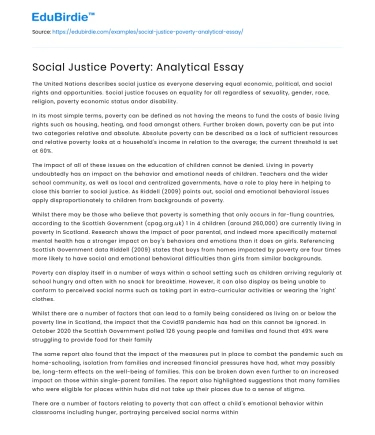The United Nations describes social justice as everyone deserving equal economic, political, and social rights and opportunities. Social justice focuses on equality for all regardless of sexuality, gender, race, religion, poverty economic status andor disability.
In its most simple terms, poverty can be defined as not having the means to fund the costs of basic living rights such as housing, heating, and food amongst others. Further broken down, poverty can be put into two categories relative and absolute. Absolute poverty can be described as a lack of sufficient resources and relative poverty looks at a household's income in relation to the average; the current threshold is set at 60%.
Save your time!
We can take care of your essay
- Proper editing and formatting
- Free revision, title page, and bibliography
- Flexible prices and money-back guarantee
The impact of all of these issues on the education of children cannot be denied. Living in poverty undoubtedly has an impact on the behavior and emotional needs of children. Teachers and the wider school community, as well as local and centralized governments, have a role to play here in helping to close this barrier to social justice. As Riddell (2009) points out, social and emotional behavioral issues apply disproportionately to children from backgrounds of poverty.
Whilst there may be those who believe that poverty is something that only occurs in far-flung countries, according to the Scottish Government (cpag.org.uk) 1 in 4 children (around 260,000) are currently living in poverty in Scotland. Research shows the impact of poor parental, and indeed more specifically maternal mental health has a stronger impact on boy's behaviors and emotions than it does on girls. Referencing Scottish Government data Riddell (2009) states that boys from homes impacted by poverty are four times more likely to have social and emotional behavioral difficulties than girls from similar backgrounds.
Poverty can display itself in a number of ways within a school setting such as children arriving regularly at school hungry and often with no snack for breaktime. However, it can also display as being unable to conform to perceived social norms such as taking part in extra-curricular activities or wearing the 'right' clothes.
Whilst there are a number of factors that can lead to a family being considered as living on or below the poverty line in Scotland, the impact that the Covid19 pandemic has had on this cannot be ignored. In October 2020 the Scottish Government polled 126 young people and families and found that 49% were struggling to provide food for their family
The same report also found that the impact of the measures put in place to combat the pandemic such as home-schooling, isolation from families and increased financial pressures have had, what may possibly be, long-term effects on the well-being of families. This can be broken down even further to an increased impact on those within single-parent families. The report also highlighted suggestions that many families who were eligible for places within hubs did not take up their places due to a sense of stigma.
There are a number of factors relating to poverty that can affect a child's emotional behavior within classrooms including hunger, portraying perceived social norms within their class, and feelings of inadequacy compared to peers of a higher, or perceived higher, socio-economic status.
A study found that children in Scotland were attending school having had no breakfast. There is no denying the impact of being hungry on someone's mood and behavior.
Feelings of 'othering' also play a part in affecting the behaviors and emotions of children from backgrounds of poverty.
Everyone within society has a role to play in minimizing the impact of poverty on children. Teachers are the people who provided they are regularly attending school, have sight of these children on a daily basis. Others within the school community would be Learning Assistants; Senior Management Team, specialist staff within schools including, but not limited to, Home-school Practitioners and Support for Learning; visiting specialists such as Social Workers as well as wider school staff such as janitorial and administrative staff.






 Stuck on your essay?
Stuck on your essay?

